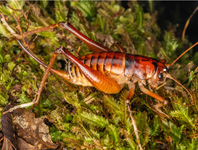Abstract
Anteholosticha sigmoidea (Foissner, 1982) Berger, 2003 was isolated from a wet soil sample collected on King George Island, Antarctica. Morphological observations and molecular phylogenetic analyses based on the gene sequences of small subunit ribosomal RNA (18S rRNA) were used to identify the species. Anteholosticha sigmoidea can be divided into two groups: group I (three populations described by Foissner 1982) and group II (described by Foissner 1984) based on the morphological differences. Group I differs from group II by the length of the midventral complex (65.1% vs. 52.5% of the cell length), the number of adoral membranelles (25–28 vs. 16–24), and the number of dorsal bristles in kinety 1 (16 bristles vs. nine bristles). Group I differs from the Antarctica population by the absence/presence of the collecting canals of the contractile vacuole and the number of macronuclear nodules (6–12 vs. 13–19). Group II differs from the Antarctica population by the number of macronuclear nodules (five to nine vs. 13–19); the arrangement of cortical granules (forming longitudinal rows vs. irregularly distributed); the length of the midventral complex (64.7% vs. 53.8% of cell length). In the phylogenetic analyses, A. sigmoidea was not nested with any species, and the gene tree indicated polyphyly of the genus Anteholosticha.
References
Berger, H. (2003) Redefinition of Holosticha Wrzesniowski, 1877 (Ciliophora, Hypotricha). European Journal of Protistology, 39, 373–379.
https://doi.org/10.1078/0932-4739-00006
Berger, H. (2006) Monograph of the Urostyloidea (Ciliophora, Hypotricha). Monographiae biologicae, 85, i–xv + 1–1303.
Berger, H. (2008) Monograph of the Amphisiellidae and Trachelostylidae (Ciliophora, Hypotricha). Monographiae biologicae, 88, i–xvi + 1–737.
Blatterer, H. & Foissner, W. (1988) Contribution to the terrestrial ciliates (Ciliophora, Protozoa) of Australia. Stapfia, 17, 1–84.
Buitkamp, U. (1977) Die Ciliatenfauna der Savanne von Lamto (Elfenbeinküste). Acta Protozoologica, 16, 249–276.
Darriba, D., Taboada, G.L., Doallo, R. & Posada, D. (2012) jModelTest 2: more models, new heuristics and parallel computing. Nature Methods, 9, 772.
https://doi.org/10.1038/nmeth.2109
Foissner, W. (1982) Ecology and taxonomy of the Hypotrichida (Protozoa: Ciliophora) of some Austrian soil. Archiv für Protistenkunde, 126, 19–143.
https://doi.org/10.1016/S0003-9365(82)80065-1
Foissner, W. (1984) Infraciliatur, Silberliniensystem und Biometrie einiger neuer und wenig bekannter terrestrischer, limnischer und mariner Ciliaten (Protozoa: Ciliophora) aus den Klassen kinetofragminophora, Colpodea und Polyhymenophora. Stapfia, Linz, 12, 1–165.
Foissner, W. (1996) Faunistics, taxonomy and ecology of moss and soil ciliates (Protozoa, Ciliophora) from Antarctica, with description of new species, including Pleuroplitoides smithi gen. n., sp. n. Acta Protozoologica, 35, 95–123.
Foissner, W. (1998) An updated compilation of world soil ciliates (Protozoa, Ciliophora), with ecological notes, new records, and descriptions of new species. European Journal of Protistology, 34, 195–235.
https://doi.org/10.1016/S0932-4739(98)80028-X
Foissner, W. (2000) A compilation of soil and moss ciliates (protozoa, ciliophora) from Germany, with new records and descriptions of new and insufficiently known species. European Journal of Protistology, 36, 253–283.
https://doi.org/10.1016/S0932-4739(00)80003-6
Foissner, W. (2014) An update of ‘basic light and scanning electron microscopic methods for taxonomic studies of ciliated protozoa’. International journal of Systematic and Evolutionary Microbiology, 64, 271–292.
https://doi.org/10.1099/ijs.0.057893-0
Foissner, W., Agatha, S. & Berger, H. (2002) Soil ciliates (Protozoa, Ciliophora) from Namibia (Southwest Africa), with emphasis on two contrasting environments, the Etosha region and the Namib desert. Part I: Text and line drawings. Denisia, 5, 1–1063.
Guindon, S., Dufayard, J.-F., Lefort, V., Anisimova, M., Hordijk, W. & Gascuel, O. (2010) New algorithms and methods to estimate maximum-likelihood phylogenies: assessing the performance of PhyML 3.0. Systematic Biology, 59, 307–321.
https://doi.org/10.1093/sysbio/syq010
Hada, Y. (1964) The fresh-water fauna of the Protozoa in the region of the Showa Station in Antarctica. Bulletin of the Suzugamine Women’s College, Natural Science, 11, 5–21.
Hall, T. (1999) BioEdit: a user-friendly biological sequence alignment editor and analysis program for Windows 95/98/NT. Nucleic Acids Symposium Series, 41, 95–98.
Huang, J., Chen, Z., Song, W. & Berger, H. (2014) Three-gene based phylogeny of the Urostyloidea (Protista, Ciliophora, Hypotricha), with notes on classification of some core taxa. Molecular Phylogenetics and Evolution, 70, 337–347.
https://doi.org/10.1016/j.ympev.2013.10.005
Jung, J.H., Park, K.M. & Kim, S. (2016) Morphology and molecular phylogeny of the soil ciliate Anteholosticha rectangula sp. nov. from King George Island, maritime Antarctica. Acta Protozoologica, 55, 89–99.
Kimura, M. (1980) A simple method for estimating evolutionary rates of base substitutions through comparative studies of nucleotide sequences. Journal of Molecular Evolution, 16, 111–120.
https://doi.org/10.1007/BF01731581
Ronquist, F., Teslenko, M., Mark, P.v.d., Ayres, D.L., Darling, A., Höhna, S., Larget, B., Liu, L., Suchard, M.A. & Huelsenbeck, J.P. (2012) MrBayes 3.2: efficient Bayesian phylogenetic inference and model choice across a large model space. Systematic Biology, 61, 539–542.
https://doi.org/10.1093/sysbio/sys029
Sonnenberg, R., Nolte, A.W. & Tautz, D. (2007) An evaluation of LSU rDNA D1-D2 sequences for their use in species identification. Frontiers in Zoology, 4, 6.
https://doi.org/10.1186/1742-9994-4-6
Sudzuki, M. (1979) On the microfauna of the Antarctic region III. Microbiota of the terrestrial interstices. Memoirs of National Institute of Polar Research, 11 (Special Issue), 104–126, pls. 1–10.
Tamura, K., Peterson, D., Peterson, N., Stecher, G., Nei, M. & Kumar, S. (2011) MEGA5: Molecular evolutionary genetics analysis using maximum likelihood, evolutionary distance, and maximum parsimony methods. Molecular Biology and Evolution, 28, 2731–2739.
https://doi.org/10.1093/molbev/msr121
Zhao, X., Gao, S., Fan, Y., Strueder-Kypke, M. & Huang, J. (2015) Phylogenetic framework of the systematically confused Anteholosticha-Holosticha complex (Ciliophora, Hypotrichia) based on multigene analysis. Molecular Phylogenetics and Evolution, 91, 238–247.
https://doi.org/10.1016/j.ympev.2015.05.021

